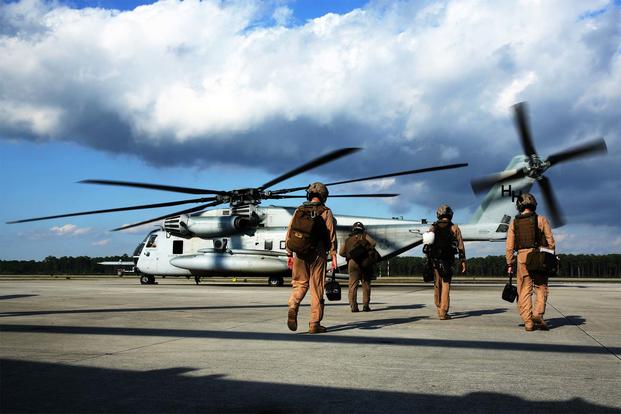After the Marine Corps hit extreme readiness lows in its battle-worn aircraft in 2014, pulling some planes off the flight line to mitigate risk, pilot flight hours and aircraft availability are slowly improving, the head of Marine aviation said Thursday.
But, he added, the service continues to feel the effects of its readiness pit, with junior pilots accumulating far fewer flight hours over time than their predecessors.
Lt. Gen. Steven Rudder, who became the Corps' deputy commandant for aviation in July, testified before the House Armed Services Committee on Thursday.
"Newly winged aviators ... [are] the foundation of the future of aviation," Rudder said in prepared testimony. "When I compare these 2017 'graduates' of their first fleet tour to the 2007 'class,' those pilots today have averaged 20 percent less flight hours over their three-year tour than the same group in 2007."
On average, he said, Marine aviators are now averaging 15.4 flight hours per crew per month (HCM), compared with 16.4 HCM a decade ago. While the current number represents a year-over-year improvement for the Marine Corps, it's still lower than optimal for pilots.
Meanwhile, he said in his prepared testimony, the service remains 20 percent shy of the congressional mandate for ready basic aircraft -- a mandate that represents "the minimum requirement for tactical proficiency."
In Marine tactical aircraft, he said, about half of the planes on flightlines are flyable.
Reduced average flight hours and readiness rates come as the Corps contends with a recent spike in aviation mishaps.
In fiscal 2017, the service's mishap rate climbed to 4.40 per 1,000 flight hours, a 10-year high. The Corps' Class-A mishap rate, involving more than $2 million in aircraft damage or loss of life, also climbed to a 10-year high, with 10 major mishaps compared with eight the previous year.
Rudder stressed that there have been no findings linking low readiness rates and Class-A mishap rates. However, he called pilot flight hours "the true metric of health in aviation."
"Chairman [of the Joint Chiefs of Staff Gen. Joseph] Dunford recently commented on the current flight hours our aircrew are getting compared to what they used to fly," Rudder said. "He also discussed the different responses a high-hour aviator and a low-hour aviator may have in a given scenario. He concludes that the high-hour aviator is better-armed to make a split-second assessment and respond to an anomalous situation correctly."
Readiness is not only a problem for the Marine Corps' most aged platforms, such as the CH-53E Super Stallions nearing retirement. The relatively new MV-22 tiltrotor Osprey has ready basic aircraft rates of 48 percent, Rudder said, a status he called "unacceptable."
"The MV-22s were deployed ahead of schedule in 2007 and have been in combat for over a decade," he said. "This high demand signal required us to put them into operation as fast as they were coming off the line."
Independent readiness reviews are now underway for most Marine aircraft platforms, including the Osprey and Super Stallion.
Rudder said the service is also using a seven-year multi-year procurement contract for Ospreys to save money and contribute more resources to efforts to modernize the aircraft and move them to a common configuration.
He asked Congress to provide stable and predictable funds that the Corps can use to modernize and fix older aircraft while it works to procure new ones.
"Marine aviation readiness is improving, but fragile," Rudder said. "Our readiness recovery lies in modernization of our aircraft, and fixing the ones we have."
-- Hope Hodge Seck can be reached at hope.seck@military.com. Follow her on Twitter at @HopeSeck.












